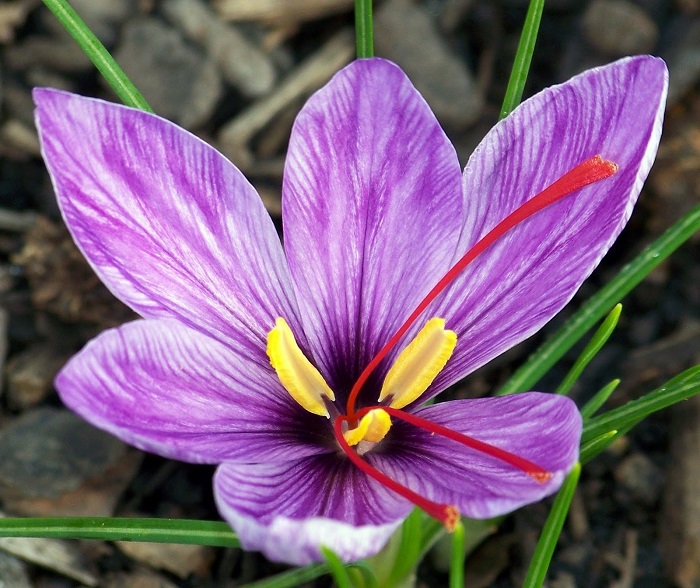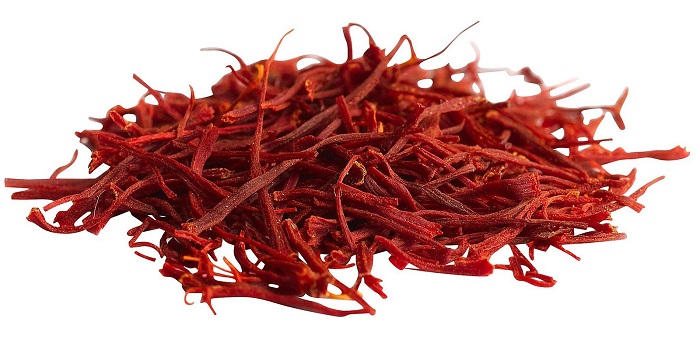Main Name: Saffron
Biological Name: Crocus sativus
Names in other languages: Azafrán (Spanish), Acafrao (Portugese), Safran (French), Kesar (Hindi), Kungumapoo (Tamil), Kunkumapoove, Kashmiram (Malayalam), Kumkuma puvvu (Telugu), Keshar (Gujarati), Jafran (Bengali), Keshar, Kesara (Marathi), Kesara, Kunkuma phul (Oriya), Zafran, Kisar (Urdu), Keshar (Punjabi)
Biological Name: Crocus sativus
Names in other languages: Azafrán (Spanish), Acafrao (Portugese), Safran (French), Kesar (Hindi), Kungumapoo (Tamil), Kunkumapoove, Kashmiram (Malayalam), Kumkuma puvvu (Telugu), Keshar (Gujarati), Jafran (Bengali), Keshar, Kesara (Marathi), Kesara, Kunkuma phul (Oriya), Zafran, Kisar (Urdu), Keshar (Punjabi)
Ever wondered that even the dried red threads or ‘stigmas’ of a flowering plant could be so exotic that one needs to think twice, or probably quite a few times, before buying just a gram of it? That’s the kind of standing the pricey saffron enjoys in the world of spices. And you shouldn’t be surprised if we share another small yet interesting piece of info. For, a single ounce of saffron is derived from over 4300 spectacularly beautiful royal purple flowers of the crocus plant. It is due to its special cultivating process that saffron is termed as the most precious spice in the world and has been nicknamed as the ‘golden spice’. With just three thread-like stigmas present in each flower, you would have to splurge out a hundred greens to buy less than an ounce of good and superior quality saffron. The spice is derived from the saffron flower which is a bulbous perennial plant belonging to the Iridaceae family and is botanically known as Crocus sativus. What is more amazing is that you just have to sprinkle a tiny pinch of this spice in your recipe due to its intense flavoring and coloring power. Reddish golden in color, saffron finds its most important use as a seasoning agent in cooking and as a coloring agent. Not just that saffron is one of nature’s highly powerful herbs, it has some secret and magnificent essential nutrients loaded which are highly useful for treating a number of common ailments and diseases. Read on to know the health benefits of saffron when taken in moderate amounts and in the right dosage.
History
Although the exact origin of saffron is still uncertain, it is believed to have come from Greece or Asia Minor, a part of Turkey, where it is still cultivated on a large scale. In fact, the world saffron also comes from the Arabic word ‘zafaran’ which means ‘yellow’. The spice appeared in ancient Babylon and China as early as 2600 BC where it was honored for healing and coloring purposes. Biblical traditions indicate that saffron was one of the most fragrant plants grown in King Solomon’s gardens. Another historic reference of saffron draws back to ancient Egypt where it was used by Cleopatra and other Pharaohs for both sacred and sensual purposes. The saffron plant was apparently introduced by the Iranians to the Greek, Roman, Chinese and Sami ethnics, including Arabs. Around 500 BC, the Persian rulers transplanted saffron in Kashmiri soils, after conquering Kashmir. However, an ancient Chinese historical explains that an Arhant Indian Buddhist missionary named Madhyantika sowed the first saffron crop when he was sent to Kashmir in the 5th century. Whatever is the origin behind the introduction of saffron to Kashmir, it has since then spread through the Indian subcontinent. While the best saffron comes from Spain, the Kashmir region of India, Iran, and Greece; Spain is the world’s largest exporter of saffron.
Although the exact origin of saffron is still uncertain, it is believed to have come from Greece or Asia Minor, a part of Turkey, where it is still cultivated on a large scale. In fact, the world saffron also comes from the Arabic word ‘zafaran’ which means ‘yellow’. The spice appeared in ancient Babylon and China as early as 2600 BC where it was honored for healing and coloring purposes. Biblical traditions indicate that saffron was one of the most fragrant plants grown in King Solomon’s gardens. Another historic reference of saffron draws back to ancient Egypt where it was used by Cleopatra and other Pharaohs for both sacred and sensual purposes. The saffron plant was apparently introduced by the Iranians to the Greek, Roman, Chinese and Sami ethnics, including Arabs. Around 500 BC, the Persian rulers transplanted saffron in Kashmiri soils, after conquering Kashmir. However, an ancient Chinese historical explains that an Arhant Indian Buddhist missionary named Madhyantika sowed the first saffron crop when he was sent to Kashmir in the 5th century. Whatever is the origin behind the introduction of saffron to Kashmir, it has since then spread through the Indian subcontinent. While the best saffron comes from Spain, the Kashmir region of India, Iran, and Greece; Spain is the world’s largest exporter of saffron.
 http://cdn.shopify.com/s/files/1/0200/5036/products/1893957_121215120039_00105.jpeg?v=1421516356
http://cdn.shopify.com/s/files/1/0200/5036/products/1893957_121215120039_00105.jpeg?v=1421516356
Health Benefits of Saffron
- Amongst all the benefits that saffron is celebrated for, protecting and preventing eye vision is one of the most important advantages. Researchers indicate that saffron is a powerful antioxidant that helps in managing the fatty acid levels in the membranes of the cells, thereby correcting vision in people with retinitis pigmentosa or macular degeneration related to age.
- Saffron is known to be an effective anti-depressant for curing mild to moderate depression. Ingesting sufficient amounts of saffron tea brings feelings of happiness and joy.
- Saffron is highly effective in inducing menstruation in women, particularly those with irregular periods. Besides reducing bleeding in the uterus, it alleviates the pain caused by menstruation.
- Apart from reducing menstrual period pains, saffron helps with alleviating the symptoms of premenstrual syndrome, including emotional stability, sore breasts, depression and fatigue.
- Saffron contains an agent called crocetin which is helpful in lowering blood pressure. When taken in the form of a tea, saffron works best in reversing high blood pressure.
- If your lungs have been inflamed due to a cold or respiratory illness, clear off the phlegm from your lungs by drinking saffron. Furthermore, saffron helps in reducing inflammation and clearing airways, thereby easing the symptoms of asthma.
- Saffron tea helps in cleansing the body from harmful toxins and substances that can otherwise lead to arthrosclerosis, a condition that hardens the arteries due to the build-up of plaque from fattening foods. When ignored, arthrosclerosis can trigger heart disease, diabetes and blood disorders.
- Stomach aches and similar ailments can be eased with saffron tea through stimulating the stomach muscles. By contracting the muscles, the tea gives cooling, soothing, and relaxing vibes.
- Crocin, Safranal, and Picrocrocin present in saffron have anti-cancer activities that combine to prevent and slow down the growth of human cancer cells.
- Using saffron in cooking on a regular basis has shown signs of improved memory power, relieved muscle pain and pain from kidney stones, and increased blood circulation.
- Preparing tea from saffron has been helpful in restricting the build up of cholesterol; thus, bringing relief from abdominal pains and managing health blood pressure.
- With a number of carotenoids present, saffron is believed to inhibit skin tumors and improve arthritis.
- It contains active constituents which help in producing positive effects on people suffering from neurodegenerative disorders. Additionally, massaging your gums with saffron reduces soreness and inflammation of the mouth and tongue.
- Saffron is beneficial to the body both internally and externally. Sores, bruises, and bug bites are some problems that can be treated and healed with the application of saffron paste.
- Other health benefits that saffron has been credited with include curing insomnia, coughing, heartburn, premature ejaculation, flatulence, indigestion, dry skin and baldness.
Saffron Nutrition FactsAmount: 100 g
Total Weight: 100 g
Total Weight: 100 g
| Nutrients | Amount |
| Basic Components | |
| Proteins | 11 g |
| Water | 11.9 g |
| Ash | 5.5 g |
| Calories | |
| Total Calories | 310 |
| Calories From Carbohydrate | 233 |
| Calories From Fat | 49 |
| Calories From Protein | 28 |
| Carbohydrates | |
| Total Carbohydrates | 65 g |
| Dietary Fiber | 3.9 g |
| Fats & Fatty Acids | |
| Total Fat | 5.9 g |
| Saturated Fat | 1.6 g |
| Monounsaturated Fat | 429 mg |
| Polyunsaturated Fat | 2.1 g |
| Omega-3 Fatty Acids | 1.2 g |
| Omega-6 Fatty Acids | 754 mg |
| Vitamins | |
| Vitamin A | 530 IU |
| Vitamin C | 81 mg |
| Thiamin | 115 mcg |
| Riboflavin | 267 mcg |
| Niacin | 1.5 mg |
| Vitamin B6 | 1 mg |
| Folate | 93 mcg |
| Minerals | |
| Calcium | 111 mg |
| Iron | 11 mg |
| Magnesium | 264 mg |
| Phosphorus | 252 mg |
| Potassium | 1.7 g |
| Sodium | 148 mg |
| Zinc | 1.1 mg |
| Copper | 328 mcg |
| Manganese | 28 mg |
| Selenium | 5.6 mcg |
 http://edalatsowda.com/en/Product/11/-Saffron–Red-Gold
http://edalatsowda.com/en/Product/11/-Saffron–Red-Gold
How many calories in saffron (per 100 gm)
Saffron has about 310 calories per 100 gm of weight.
Saffron has about 310 calories per 100 gm of weight.
How to Buy Saffron
- Saffron is sold in both powdered form and whole threads (whole stigmas). It is best to buy whole threads as they retain their flavor and are more powerful than the ground varieties.
- Powered saffron loses its color and flavor very quickly. Thus, opt for whole red threads of saffron for best and assured quality.
- It is always recommended to purchase saffron from a reliable shop to ensure the quality of saffron, especially in case of powdered saffron as it is likely to be adulterated with turmeric, fillers, imitations, or other additives.
- Pick up sealed packets of saffron that has the date of packaging and date of expiry printed on them.
- Since very little is required, ground saffron is available in packets of 1/16 of a teaspoon while threads are found in ¼ gram or ½ of a teaspoon.
- Check the freshness of saffron by observing its color. It should be bright orange-yellow hued and each thread should measure 2 to 4 cm in length. Any grey color streaks or light spots on the stigmas should be avoided.
Saffron Storage Tips
- Saffron should be wrapped in foil and stored in an airtight container in a cool, dark place away from light since direct light rays can oxidize the pigments present in saffron and reduce its flavor.
- With proper storage and handling tips, saffron can be kept for up to six months.
- Although saffron can last up to minimum three years and does not spoil, it tends to lose its flavor as it ages.

